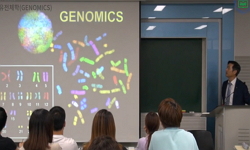원핵 세포는 핵양체 결합 단백질(NAP)로 알려진 다양한 히스톤 유사 단백질을 가지고 있다. 이들은 DNA의 AT-rich 서열에 결합하여, DNA 자체를 감싸거나, 구부리거나, 떨어져 있는 DNA 가닥을 연결...
http://chineseinput.net/에서 pinyin(병음)방식으로 중국어를 변환할 수 있습니다.
변환된 중국어를 복사하여 사용하시면 됩니다.
- 中文 을 입력하시려면 zhongwen을 입력하시고 space를누르시면됩니다.
- 北京 을 입력하시려면 beijing을 입력하시고 space를 누르시면 됩니다.


박테리아의 히스톤 유사 단백질에 의한 유전자 발현 조절 = Regulation of gene expression by histone-like proteins in bacteria
한글로보기https://www.riss.kr/link?id=A105300123
-
저자
박신애 (강원대학교) ; 이정신 (강원대학교) ; Park, Shinae ; Lee, Jung-Shin

- 발행기관
- 학술지명
- 권호사항
-
발행연도
2018
-
작성언어
Korean
-
주제어
gene expression ; histone-like protein ; H-NS ; HU ; NAP
-
등재정보
KCI등재,SCOPUS
-
자료형태
학술저널
- 발행기관 URL
-
수록면
1-8(8쪽)
-
KCI 피인용횟수
0
- DOI식별코드
- 제공처
- 소장기관
-
0
상세조회 -
0
다운로드
부가정보
국문 초록 (Abstract)
원핵 세포는 핵양체 결합 단백질(NAP)로 알려진 다양한 히스톤 유사 단백질을 가지고 있다. 이들은 DNA의 AT-rich 서열에 결합하여, DNA 자체를 감싸거나, 구부리거나, 떨어져 있는 DNA 가닥을 연결시키는 다리 역할을 하여, 결국에는 원핵 생물의 유전자 발현을 조절한다. NAP는 특히 전사의 억제 기능을 가지고 있기 때문에, 유전자 발현 억제에 있어서 이들의 역할과, 구체적인 메커니즘을 밝히는 것을 매우 중요한 일이다. 본 논문에서는 잘 알려져 있는 NAP인 H-NS와 HU에 대하여 정리하였고, 특히 E. coli와 Salmonella Typhimurium에서 이들의 유전자 발현에 대한 기능을 요약하였다. H-NS는 이들의 올리고머화와 필라멘트 구조 형성을 통하여 Salmonella와 같은 사람에 감염하는 병원성 세균의 독성유전자 발현을 억제할 수 있고, 이런 기능을 수행하였을 때 다른 NAP와 함께 작용할 수 있다. 최근에 H-NS는 사람에게 typhoid fever와 systemic disease를 발생시키는 독성물질인, typhoid toxin의 발현 또한 조절할 수 있음이 밝혀졌다. Salmonella에서 HU 또한 독성 유전자뿐만 아니라, 이들의 생리적 기능에 중요한 유전자들의 발현을 조절할 수 있다. 따라서, H-NS와 HU와 같은 NAP들이 원핵 생물의 독성 유전자 발현의 분자적인 메커니즘을 밝히는데 중요한 요소임을 제시한다.
다국어 초록 (Multilingual Abstract)
A prokaryotic cell has various histone-like proteins also known as nucleoid-associated proteins (NAPs). These proteins bind AT-rich sequence at DNA, which induce DNA wrapping, bending, and bridging, and subsequently regulate the gene expression in bac...
A prokaryotic cell has various histone-like proteins also known as nucleoid-associated proteins (NAPs). These proteins bind AT-rich sequence at DNA, which induce DNA wrapping, bending, and bridging, and subsequently regulate the gene expression in bacteria. Because NAPs function in transcriptional silencing of virulence genes, it is important to study their roles in gene silencing and specific mechanisms of these proteins. In this review, we discussed two well-known NAPs, H-NS, and HU, and summarized their roles for gene expression in Escherichia coli and Salmonella Typhimurium. Through the oligomerization and filamentation of H-NS, it represses the expression of virulence genes in human pathogenic bacteria, such as Salmonella Typhimurium, and it works with other NAPs positively or negatively. Recently, H-NS also regulates typhoid toxin expression, which causes typhoid fever and systemic disease in human. Additionally, HU regulates the expression of genes related to both virulence and physiology of Salmonella. Therefore, we suggest that NAPs like H-NS and HU are crucial factors to reveal the molecular mechanisms of virulence gene expression in bacteria.
참고문헌 (Reference)
1 Sònia Paytubi, "YdgT, the Hha paralogue in Escherichia coli, forms heteromeric complexes with H-NS and StpA" Wiley 54 (54): 251-263, 2004
2 Singh, K., "Xenogeneic silencing and its impact on bacterial genomes" 70 : 199-213, 2016
3 Laurent Claret, "Variation in HU composition during growth of Escherichia coli: the heterodimer is required for long term survival" Elsevier BV 273 (273): 93-104, 1997
4 Don Walthers, "The response regulator SsrB activates expression of diverse Salmonella pathogenicity island 2 promoters and counters silencing by the nucleoid-associated protein H-NS" Wiley 65 (65): 477-493, 2007
5 Spurio, R, "The oligomeric structure of nucleoid protein H-NS is necessary for recognition of intrinsically curved DNA and for DNA bending" 16 : 1795-1805, 1997
6 Oliver Schröder, "The bacterial DNA-binding protein H-NS represses ribosomal RNA transcription by trapping RNA polymerase in the initiation complex" Elsevier BV 298 (298): 737-748, 2000
7 Jacques Oberto, "The HU Regulon Is Composed of Genes Responding to Anaerobiosis, Acid Stress, High Osmolarity and SOS Induction" Public Library of Science (PLoS) 4 (4): e4367-, 2009
8 Vanessa Bloch, "The H-NS dimerization domain defines a new fold contributing to DNA recognition" Springer Nature 10 (10): 212-218, 2003
9 Anna Balandina, "The Escherichia coli histone-like protein HU regulates rpoS translation" Wiley 39 (39): 1069-1079, 2001
10 Chiharu Ueguchi, "Systematic Mutational Analysis Revealing the Functional Domain Organization ofEscherichia coliNucleoid Protein H-NS" Elsevier BV 263 (263): 149-162, 1996
1 Sònia Paytubi, "YdgT, the Hha paralogue in Escherichia coli, forms heteromeric complexes with H-NS and StpA" Wiley 54 (54): 251-263, 2004
2 Singh, K., "Xenogeneic silencing and its impact on bacterial genomes" 70 : 199-213, 2016
3 Laurent Claret, "Variation in HU composition during growth of Escherichia coli: the heterodimer is required for long term survival" Elsevier BV 273 (273): 93-104, 1997
4 Don Walthers, "The response regulator SsrB activates expression of diverse Salmonella pathogenicity island 2 promoters and counters silencing by the nucleoid-associated protein H-NS" Wiley 65 (65): 477-493, 2007
5 Spurio, R, "The oligomeric structure of nucleoid protein H-NS is necessary for recognition of intrinsically curved DNA and for DNA bending" 16 : 1795-1805, 1997
6 Oliver Schröder, "The bacterial DNA-binding protein H-NS represses ribosomal RNA transcription by trapping RNA polymerase in the initiation complex" Elsevier BV 298 (298): 737-748, 2000
7 Jacques Oberto, "The HU Regulon Is Composed of Genes Responding to Anaerobiosis, Acid Stress, High Osmolarity and SOS Induction" Public Library of Science (PLoS) 4 (4): e4367-, 2009
8 Vanessa Bloch, "The H-NS dimerization domain defines a new fold contributing to DNA recognition" Springer Nature 10 (10): 212-218, 2003
9 Anna Balandina, "The Escherichia coli histone-like protein HU regulates rpoS translation" Wiley 39 (39): 1069-1079, 2001
10 Chiharu Ueguchi, "Systematic Mutational Analysis Revealing the Functional Domain Organization ofEscherichia coliNucleoid Protein H-NS" Elsevier BV 263 (263): 149-162, 1996
11 D. C. Grainger, "Structure and function of bacterial H-NS protein" Portland Press Ltd. 44 (44): 1561-1569, 2016
12 B. R. G. Gordon, "Structural basis for recognition of AT-rich DNA by unrelated xenogeneic silencing proteins" Proceedings of the National Academy of Sciences 108 (108): 10690-10695, 2011
13 Mara Giangrossi, "Selective expression of the β-subunit of nucleoid-associated protein HU during cold shock in Escherichia coli" Wiley 44 (44): 205-216, 2002
14 W. W. Navarre, "Selective Silencing of Foreign DNA with Low GC Content by the H-NS Protein in Salmonella" American Association for the Advancement of Science (AAAS) 313 (313): 236-238, 2006
15 Charles J Dorman, "Regulation of gene expression by histone-like proteins in bacteria" Elsevier BV 13 (13): 179-184, 2003
16 Andrew J Bannister, "Regulation of chromatin by histone modifications" Springer Nature 21 (21): 381-395, 2011
17 Miano, A, "Proteins from the prokaryotic nucleoid I. Effect of NS1 and NS2 (HU) proteins on the thermal stability of DNA" 5 : 415-422, 1982
18 Ci Ji Lim, "Nucleoprotein filament formation is the structural basis for bacterial protein H-NS gene silencing" Springer Nature 2 (2): 2012
19 M. W. Mangan, "Nucleoid-associated protein HU controls three regulons that coordinate virulence, response to stress and general physiology in Salmonella enterica serovar Typhimurium" Microbiology Society 157 (157): 1075-1087, 2011
20 Yasunobu Kano, "Molecular cloning and nucleotide sequence of the HU-1 gene of Escherichia coli" Springer Nature 201 (201): 360-362, 1985
21 P G Jones, "Induction of proteins in response to low temperature in Escherichia coli." American Society for Microbiology 169 (169): 2092-2095, 1987
22 Roee Amit, "Increased Bending Rigidity of Single DNA Molecules by H-NS, a Temperature and Osmolarity Sensor" Elsevier BV 84 (84): 2467-2473, 2003
23 A. La Teana, "Identification of a cold shock transcriptional enhancer of the Escherichia coli gene encoding nucleoid protein H-NS." Proceedings of the National Academy of Sciences 88 (88): 10907-10911, 1991
24 Drlica, K., "Histonelike proteins of bacteria" 51 : 301-319, 1987
25 V. H. Bustamante, "HilD-mediated transcriptional cross-talk between SPI-1 and SPI-2" Proceedings of the National Academy of Sciences 105 (105): 14591-14596, 2008
26 L. C. Martinez, "HilD Induces Expression of Salmonella Pathogenicity Island 2 Genes by Displacing the Global Negative Regulator H-NS from ssrAB" American Society for Microbiology 196 (196): 3746-3755, 2014
27 Winardhi, R.S, "Higher order oligomerization is required for H-NS family member MvaT to form gene-silencing nucleoprotein filament" 40 : 8942-8952, 2012
28 S. T. Arold, "H-NS forms a superhelical protein scaffold for DNA condensation" Proceedings of the National Academy of Sciences 107 (107): 15728-15732, 2010
29 Diego Esposito, "H-NS Oligomerization Domain Structure Reveals the Mechanism for High Order Self-association of the Intact Protein" Elsevier BV 324 (324): 841-850, 2002
30 Sacha Lucchini, "H-NS Mediates the Silencing of Laterally Acquired Genes in Bacteria" Public Library of Science (PLoS) 2 (2): e81-, 2006
31 Ueda, T, "Functions of the Hha and YdgT proteins in transcriptional silencing by the nucleoid proteins, H-NS and StpA, in Escherichia coli" 20 : 263-271, 2013
32 Swinger, K.K, "Flexible DNA bending in HU-DNA cocrystal structures" 22 : 3749-3760, 2003
33 J. M. Nieto, "Expression of the hemolysin operon in Escherichia coli is modulated by a nucleoid-protein complex that includes the proteins Hha and H-NS" Springer Nature 263 (263): 349-358, 2000
34 J. M. Nieto, "Evidence for Direct Protein-Protein Interaction between Members of the Enterobacterial Hha/YmoA and H-NS Families of Proteins" American Society for Microbiology 184 (184): 629-635, 2002
35 Kahramanoglou, C, "Direct and indirect effects of H-NS and Fis on global gene expression control in Escherichia coli" 39 : 2073-2091, 2011
36 J. Johansson, "Differential protease-mediated turnover of H-NS and StpA revealed by a mutation altering protein stability and stationary-phase survival of Escherichia coli" Proceedings of the National Academy of Sciences 96 (96): 10776-10781, 1999
37 Masanori Mitta, "Deletion analysis of cspA of Escherichia coli : requirement of the AT‐rich UP element for cspA transcription and the downstream box in the coding region for its cold shock induction" Wiley 26 (26): 321-335, 2003
38 Casey C. Fowler, "Decoding a Salmonella Typhi Regulatory Network that Controls Typhoid Toxin Expression within Human Cells" Elsevier BV 23 (23): 65-76.e6, 2018
39 R. T. Dame, "DNA Bridging: a Property Shared among H-NS-Like Proteins" American Society for Microbiology 187 (187): 1845-1848, 2005
40 W Bae, "CspA, the major cold shock protein of Escherichia coli, negatively regulates its own gene expression." American Society for Microbiology 179 (179): 7081-7088, 1997
41 Rachel Cerdan, "Crystal Structure of the N-terminal Dimerisation Domain of VicH, the H-NS-like Protein of Vibrio cholerae" Elsevier BV 334 (334): 179-185, 2003
42 David A Schneider, "Control of rRNA expression in Escherichia coli" Elsevier BV 6 (6): 151-156, 2003
43 Ephraim Fass, "Control of Salmonella pathogenicity island-2 gene expression" Elsevier BV 12 (12): 199-204, 2009
44 Yasunobu Kano, "Cloning and sequencing of the HU-2 gene of Escherichia coli" Springer Nature 209 (209): 408-410, 1987
45 Chiharu Ueguchi, "Clarification of the dimerization domain and its functional significance for the Escherichia coli nucleoid protein H-NS" Elsevier BV 274 (274): 145-151, 1997
46 J. Rouviere-Yaniv, "Characterization of a novel, low-molecular-weight DNA-binding protein from Escherichia coli." Proceedings of the National Academy of Sciences 72 (72): 3428-3432, 1975
47 Kotlajich, M.V, "Bridged filaments of histone-like nucleoid structuring protein pause RNA polymerase and aid termination in bacteria" 4 : e04970-, 2015
48 Shane C. Dillon, "Bacterial nucleoid-associated proteins, nucleoid structure and gene expression" Springer Nature 8 (8): 185-195, 2010
49 Jeremy R. Ellermeier, "Adaptation to the host environment: regulation of the SPI1 type III secretion system in Salmonella enterica serovar Typhimurium" Elsevier BV 10 (10): 24-29, 2007
50 Y. Liu, "A divalent switch drives H-NS/DNA-binding conformations between stiffening and bridging modes" Cold Spring Harbor Laboratory 24 (24): 339-344, 2010
동일학술지(권/호) 다른 논문
-
전사체와 대사물질 구조분석을 통한 Novosphingobium pentaromativorans US6-1의 dibenzofuran 분해 경로 해석
- 한국미생물학회
- 나혜윤
- 2018
- KCI등재,SCOPUS
-
Propionibacterium acnes에 의해 유도되는 염증반응에서 Cnestis palala (Lour.) Merr. 추출물의 억제효과
- 한국미생물학회
- 신진학
- 2018
- KCI등재,SCOPUS
-
경기도에서 분리된 Campylobacter jejuni의 유전자 패턴 분석 연구
- 한국미생물학회
- 김운호
- 2018
- KCI등재,SCOPUS
-
2014-2015년 경기지역 노로바이러스성 식중독의 분자역학적 특성분석
- 한국미생물학회
- 남수정
- 2018
- KCI등재,SCOPUS
분석정보
인용정보 인용지수 설명보기
학술지 이력
| 연월일 | 이력구분 | 이력상세 | 등재구분 |
|---|---|---|---|
| 2023 | 평가예정 | 해외DB학술지평가 신청대상 (해외등재 학술지 평가) | |
| 2020-01-01 | 평가 | 등재학술지 유지 (해외등재 학술지 평가) |  |
| 2013-12-02 | 학술지명변경 | 외국어명 : The Korean Journal of Microbiology -> Korean Journal of Microbiology |  |
| 2010-01-01 | 평가 | 등재학술지 유지 (등재유지) |  |
| 2008-01-01 | 평가 | 등재학술지 유지 (등재유지) |  |
| 2006-01-01 | 평가 | 등재학술지 유지 (등재유지) |  |
| 2004-01-01 | 평가 | 등재학술지 유지 (등재유지) |  |
| 2001-01-01 | 평가 | 등재학술지 선정 (등재후보2차) |  |
| 1998-07-01 | 평가 | 등재후보학술지 선정 (신규평가) |  |
학술지 인용정보
| 기준연도 | WOS-KCI 통합IF(2년) | KCIF(2년) | KCIF(3년) |
|---|---|---|---|
| 2016 | 0.21 | 0.21 | 0.21 |
| KCIF(4년) | KCIF(5년) | 중심성지수(3년) | 즉시성지수 |
| 0.26 | 0.24 | 0.48 | 0.02 |




 ScienceON
ScienceON







